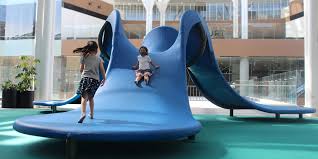How to Design Play Spaces That Inspire Imagination

Imagination is one of the greatest qualities you can give a kid. Kids with open, wild, free imaginations are often more likely to be able to think outside of the box. They are also typically better at problem-solving and navigating life well into adulthood. Furthermore, kids with active imaginations commonly perform better academically. And since most of what kids do when they’re still little is play, designing play spaces that inspire imagination is imperative.
Combine Open Space and Structure
Wherever you are designing a play space, you’ll want to ensure you have a combination of both open, free place spaces and solid structures. This combination will give children options and alternatives. Sometimes, kids get bored with the same old swings and slides. Other times, they long for creative ways to climb, scale, and jump. A play space with only a structure might get old after enough time passes, and one with no structure may lack inspiration.
The best of both worlds is to install playground equipment that encourages kids to play in different areas at varying heights. Then, in the surrounding areas, make sure children have access to plenty of wide open space to run, hide, and make up their own games. An ideal space will have enough room for both. The playground structure should flow seamlessly into its natural surroundings, so kids can move from one space to the other.
Include Green Space
Even better, the playground will be set in green space. Quite often, schools, parks, and playgrounds are surrounded by concrete and metal. Of course, you may not have any say in the lot on which you are designing your play space. However, young children without access to green space can suffer from an increase in mental health issues like depression and anxiety. It’s difficult to draw on your imagination while struggling with mental health issues.
While the space you’re designing may not have natural green space, you can always add it. Invest in young trees and plant them near the playground. Lay down grass or other ground cover for kids to make contact with. To take this access to green space a step further, you can even start a garden and get the kids involved. Children’s imaginations will surely benefit from learning to plant and nurture flowers and food.
Provide Rudimentary Tools
You may have seen play spaces that have toys, musical instruments, and other forms of entertainment ready-made for kids. And those structures can be amazing. The only problem is, again, kids can grow bored of the same toys that basically have one function, day after day. Eventually, children will tire of beating the same drum and playing the same game over and over. Then, you’ll have an abandoned play space with children looking for something more, probably online or behind a screen.
This doesn’t mean you can’t include any cool toys or instruments. It just means you should also include some rudimentary tools like large blocks, wooden shapes, baskets, sticks, and other basics for kids to use. With this type of equipment, kids can build all sorts of things, using their imaginations to create castles, towers, vehicles, roadways, and more. You may even find them collaborating on ways to utilize these tools, another critical skill children can develop young.
Include Age Appropriate Challenges
A common issue for kids as they grow is that they are not challenged enough, mentally or physically. You’ve likely heard of or experienced children who act out in class because they’re bored with schoolwork that comes easy for them. The same logic applies to outdoor spaces and structures. As kids grow, they need ever-greater challenges that allow them to stretch the limits of what their bodies and minds are capable of.
To ensure kids are appropriately challenged, include structures, equipment, and tools for various age levels. Kids as young as three can start using a hammer, and they can apply math and science skills to gardening. The more challenging the playtime is for kids, the more fun they will often have, especially when they’re left to their own devices. Give them access to the tools, structures, and equipment, be present for guidance, and set them free.
Go to the Source
Finally, if you’re around kids a lot, you have likely heard the refrain that “adults think they know everything.” It’s hard to be a kid who feels like they have no control and no input into their lives. And this kind of hyper-organized and orchestrated environment certainly will not contribute to more vivid imaginations. If anything, children will likely grow up feeling stifled and resentful of parents, teachers, and caregivers who rarely ask for their input.
So, if you’re wondering what kinds of play spaces are best to inspire kids’ imaginations, ask them. Give kids options, show them multiple designs, get curious, and stay open. One of the greatest qualities of children is that they are usually quite honest. They will let you know what they want, and they will often even tell you why. Bring together the best and brightest minds in design and the children who will be engaging with the final product, and expect great results.
In the end, there are myriad ways you can design play spaces that inspire the imaginations of children of all ages. You can work with large and small spaces, and your structures can be large and imposing or small and simple. Be sure to include the essential elements of mixing free play with organized structures, green space, rudimentary tools, challenges, and feedback from kids. From there, children will be hard-pressed not to get wildly creative in the best possible ways.





